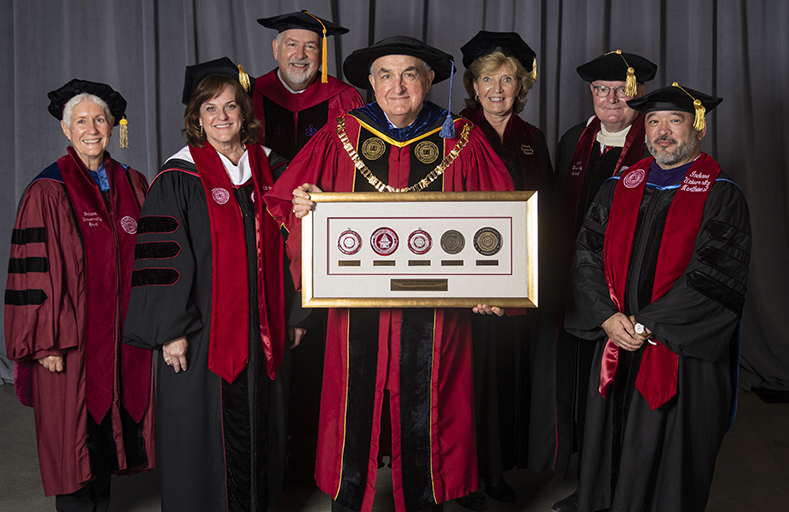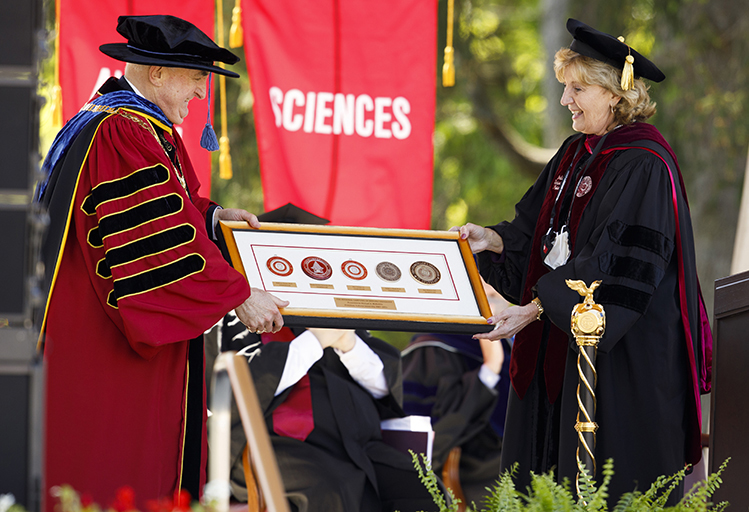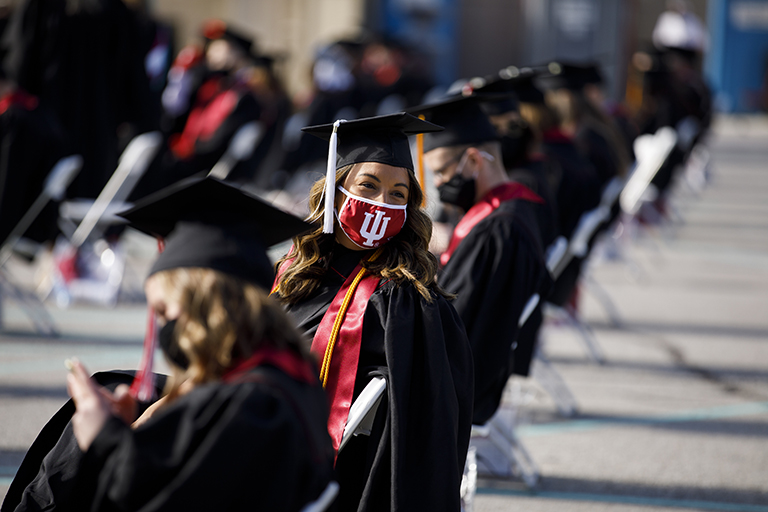As Indiana University President Michael A. McRobbie presides this week over in-person commencement ceremonies at each of IU's regional campuses across the state, he is being honored in an unprecedented way for his contributions to those campuses and the communities they serve.
McRobbie, who will retire next month after 14 years as IU president, is being awarded with the Chancellor's Medallion at each of IU's five regional campuses, located in Gary, Kokomo, New Albany, Richmond and South Bend. The award, the highest honor presented by a regional campus chancellor, is bestowed upon individuals or organizations who have provided distinguished service to the university and its surrounding communities.
Beginning in the early 1990s, regional campuses began recognizing distinguished service to their campus communities with the campus Chancellor’s Medallion. In that time, 173 medals have been presented to individuals or organizations by regional campus chancellors.
McRobbie is the first individual to be honored by all five of the IU regional campuses with this special recognition. He received the first two of these honors during Commencement ceremonies that were held on May 10 and 11 at the IU Southeast campus in New Albany and at the IU Kokomo campus, respectively. McRobbie also received an honorary IU degree, the highest academic honor the university can bestow, during IU Bloomington's spring undergraduate Commencement ceremony on May 8.
In receiving the Chancellor's Medallion at each regional campus, McRobbie, currently one of the longest-serving college or university presidents in the nation, is being recognized for presiding over a dramatic transformation during his presidency in IU's academic programs, physical facilities and philanthropic culture.
He also is being acknowledged for serving as a "steadfast champion" of the mission of IU's regional campuses, which, collectively, educate one in five degree-seeking students at IU. During IU's spring commencement ceremonies, IU will confer 4,070 of its total 21,145 degrees earned at the regional campuses.
"[President McRobbie has] promoted, with tremendous success, our goals of an excellent, affordable, learner-centered education for our students; deep community and regional engagement; and a collaborative structure and culture that is unique in American higher education, and indeed serves as a model for others," said Susan Sciame-Giesecke, IU Kokomo chancellor and IU's senior regional campus chancellor.
The regional campus chancellors are also recognizing McRobbie for helping to generate "unprecedented philanthropic support" for their campuses in the recently completed "For All Bicentennial Campaign". Together, IU's regional campuses raised nearly $83 million during the university's first university-wide philanthropic campaign, which is enabling them to provide a high-quality and distinctive educational experience that fulfills the educational and career needs and aspirations of students; to tackle the difficult work of increasing the number of Hoosiers with valuable degrees; and to continue to improve graduation rates for students with a wide variety of backgrounds and educational and life experiences.
Last week, McRobbie delivered his 14th and final State of the University address. In his speech, he highlighted recent systematic changes to IU regional campuses, which have been largely brought about by IU's blueprint plan for advancing the campuses' goals. These changes, he said, have strengthened collaboration among the campuses around a common mission to serve the educational needs of a broad segment of Hoosier students and returning adult learners, while also engaging deeply with the needs of their surrounding communities.
In recent years, IU's regional campuses have positioned themselves as a first choice for Hoosier students who seek baccalaureate degrees or selected master’s degrees in a setting that is close to home and provides both flexibility and the resources of a major public university. They have done so, McRobbie said, by maintaining tuition rates that are lowest among four-year publics in the state, adding new degree programs that are relevant and responsive to students' evolving needs, and focusing on "excellent teaching."
During his address, McRobbie noted a sizeable improvement during his presidency in the six-year graduation rate on IU's regional campuses, which have traditionally had lower graduation rates owing to their students’ educational backgrounds and socio-economic statuses. The rate has increased from 24 percent to 38 percent.
McRobbie also underscored "the growing stature" of the regional campuses within the larger IU system, as reflected by the campuses' increasing participation in university governance, in special-purpose or ad-hoc planning groups, and in strategic efforts to ensure IU continues to achieve its ultimate aim of ensuring the success of its students.
"Clearly, the future of these campuses lies in closer connections with the broader university and never again to be distanced from it," McRobbie said.




